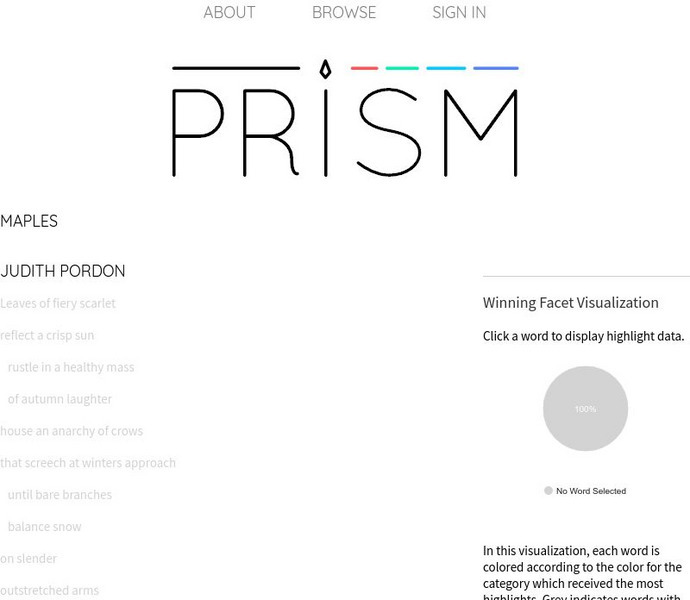Hi, what do you want to do?
Curated OER
The Unraveling of a Poem
Students study poetry and poets from different countries and time periods. They analyze various poems, present a dramatic reading of a poem and teach a poem they like to their class.
Curated OER
The First World War
Students examine the process and effects of World War I on different segments of the population, beyond the political, diplomatic and military framework of the war. They analyze the memoirs of soldiers, read poetry of the time, and...
Curated OER
Let Freedom Ring: The Life & Legacy of Martin Luther King, Jr.
Students use text and photos to visualize the delivery of Dr. Martin Luther King, Jr.'s historic "I Have A Dream" speech. They analyze Dr. King's speech for examples of imagery and allusion and create original poetry and illustrations...
Alabama Learning Exchange
J. Alfred Hyperbolizes
Mermaids will sing to your class members as they engage in an activity related to T.S. Eliot's famous dramatic interior monologue. After engaging in a socratic seminar about literary devices in the poem, individuals choose one...
National Endowment for the Humanities
Jacob Lawrence's Migration Series: Removing the Mask
Describe, analyze, compare and contrast poets from the Harlem Renaissance. Critical thinkers analyze the imagery, characterization, tone, symbolism, and historical context of Jacob Lawrence, Helene Johnson, and Paul Laurence Dunbar. A...
Curated OER
Picturing Shakespeare: Creating Illuminated Texts
Students experiment with illuminating important text. In this fictional literature lesson, students research Shakespearean sonnets. Students identify key elements of the sonnets, and examine the relationship between...
Curated OER
The Art of Romare Bearden
Students examine the works of artist Romare Bearden. In an online activity, they scrutinize his work, "Tomorrow I May Be Far Away." by moving the mouse over it. Students also compose poems inspired by one of Bearden's works.
Curated OER
Picture This!
Learners practice visualizing images as they read text to help improve their comprehension skills. The teacher models a visualizing technique, and the passes out two poems for the students to read silently. The class creates a Venn...
Curated OER
Imagination Express
Students create an artistic response to the book, The Polar Express. In this creative writing lesson, students read the book and visualize an imaginary journey they would like to go on. Students create a train car from construction paper...
Curated OER
Lesson Three: Go Free or Die
Fourth graders look for sensory details and figurative language. In this reading strategy lesson plan, 4th graders read the story Go Free or Die by J. Ferris and complete a chart with figurative language. They use a word wall in the...
Curated OER
Read It, See It!
Students review the concept of silent reading and discuss the meaning of visualization. They listen to a poem as it is read and close their eyes to try to make a picture of what is happening and think about the qualities the wind...
Curated OER
Comprehension
Students identify that comprehension is an essential component or reading and in order to be efficient and fluent readers. They interpret what they have read through various strategies. Finally, students use one of the strategies,...
Curated OER
Tell Me That You Love Me 5-7-5
Learners listen to several examples of Haiku poetry and discuss the strict format. Then students create and edit their own Haiku poems and enhance them with ink designs.
Curated OER
Freedmen's Bureau
Students examine the African American experience after they received their freedom after the Civil War. They complete a Mind Map, read and analyze a poem, and write a paragraph using key vocabulary words. They analyze the impact of the...
Curated OER
Haiku: The Power of Nature and Emotion
Introduce your students to the famous Japanese Haiku with these great ideas for the classroom.
Curated OER
Stain My Days Blue
Pupils read several poems related to the life and culture of the Appalachia region. They are introduced to the poetic forms of simile, alliteration and onomatopoeia and respond to the poems through journal entries and poetry of their own.
Curated OER
Use of the Simile
Fourth graders identify and write their own similes. In this literary devices lesson, 4th graders define and identify similes. The teacher scaffolds the lesson so that all students can write their own similes.
Curated OER
The Death of the Ball Turret Gunner
Students read and analyze a poem about a speaker's posthumous view of war, assess the purpose of an author's note and evaluate the effect of the point of view on the reader's response. They work in groups to discuss and analyze the poem.
Curated OER
Getting To Know You
Students prepare for and respond to literature selections. This package includes ten lessons from the American Literature series, each covering a different reading selection. Pre-reading and response activities are included for each...
Curated OER
Comparing Characters Across Two Short Stories
Ninth graders listen to a read aloud of two short stories focusing on literary devices. The write about the settings and realism of the stories, and decide each main character handles the conflict he faces with nature.
PBS
Pbs Learning Media: Literary Elements and Techniques: Imagery
Explore the literary technique of imagery to see how sensory language contributes to the meaning and feeling of a poem in this animated video [1:23] from WNET. Discussion questions below help students to further apply their understanding...
Alabama Learning Exchange
Alex: Capturing a Moment in Time
This lesson allows the students to explore imagery poetry through the use of a digital camera. The students visualize an imagery poem then look at a painting that pays tribute to the poem. Then the students think of a moment in time...
University of Virginia Library
Prism: "Maples" Visualization
[Free Registration/Login Required] See the results of how users have highlighted Judith Pordon's "Maples." Imagery is blue while personification is red and archetype is green. Click on any word to see the percentage of users that...
TED Talks
Ted: Ted Ed: The Poet Who Painted With His Words
Among the great poets of literary history, certain names like Homer, Shakespeare and Whitman are instantly recognizable. However, there's an early 20th century great poet whose name you may not know: Guillaume Apollinaire. Genevieve Emy...




























